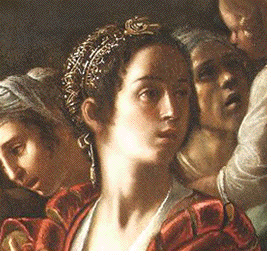...Best of Sicily presents... Best of Sicily Magazine. ... Dedicated to Sicilian art, culture, history, people, places and all things Sicilian. |
by Antonella Gallo | ||
Magazine Index Best of Sicily Arts & Culture Fashion Food & Wine History & Society About Us Travel Faqs Contact Map of Sicily |
Among Minniti's better known surviving works are the Miracle at Nain (a detail is shown here; regional art gallery at Messina), the Martyrdom of Saint Lucy, Miracle of Saint Clare, (both at the regional art gallery in Palazzo Bellomo, Siracusa), Saint Benedict, Madonna with Child and Saints Cosimo and Damian (Church of Saint Mary, Modica), and Saint John the Baptist (Messina). His work was usually faithful to sources; the miracle of Nain is described in Luke 7, 11-17. In 1606, Caravaggio spent some time in Sicily, having fled Rome following a brawl he probably instigated. Minniti hosted him at his home in Siracusa. Caravaggio, who later fled some problems in Malta and returned to work in Sicily in 1608, died in 1610 while returning to Rome. Despite everything, to refer to Minniti as the "Sicilian Caravaggio" would be unfair. He had his own artistic style, though his technique and use of painting media were certainly borrowed from Caravaggio. Both masters enjoyed the advantage of living in an era of particular church-building activity. Commissions were frequent. As he reached middle age, Minniti's lifestyle became more tranquil and ordered than the late Caravaggio's. (Caravaggio, too, might have changed had he lived longer.) Mario Minniti was one of the most distinguished Sicilian painters of his era. Indeed, he is one of the few Sicilian painters of the early seventeeth century whose work is still preserved and may be viewed today. Much of the painting to be seen in Sicilian churches today actually dates from the eighteenth century, or at all events the years following the era of Caravaggio and Menniti. Mario Minniti died at Siracusa in 1640. About the Author: Antonella Gallo, who teaches art in Rome, has written numerous articles on arts and artists for Best of Sicily. | |
Top of Page |
 Born in Siracusa (Syracuse) in 1577, Mario Minniti was one of the better known and more distinguished pupils of Caravaggio (Michelangelo Merisi), who
was just a few years older, and in many respects his work shares the same
characteristic style. At the age of fifteen, following the death of his
father, Minniti apprenticed in Rome, where he soon met Caravaggio. The two
became friends and collaborators. Minniti learned Caravaggio's style and
techniques, and shared the elder master's passion for adventure --often
in violent incidents on the streets and at taverns. It appears that they
sometimes flirted with other men's wives or girlfriends, or insulted people
who challenged them in discussion. Minniti is studied as much for his wild
reputation as for his painting. In fact, he used Caravaggio's opaque beeswax
and oil technique to great effect, creating stunning shadows and light in
portraiture, particularly in works rendered around 1625. His style evolved
over the years, eventually achieving a bold, lively Baroque realism. In
truth, Minniti's work was much in demand by the Counter Reformation Church,
and his career in Sicily was an exceptionally successful one. (Not that the Reform Movement itself stirred many sentiments in conservative, Catholic Sicily that had to be countered, as the Holy Inquisition was in full swing --nor is it thought that Minniti himself entertained reactionary theological opinions; we only wish to say that this artistic theme was part of a general trend.) He spent much of his time in Siracusa and Messina, as well as Palermo, with several commissions in Malta.
Born in Siracusa (Syracuse) in 1577, Mario Minniti was one of the better known and more distinguished pupils of Caravaggio (Michelangelo Merisi), who
was just a few years older, and in many respects his work shares the same
characteristic style. At the age of fifteen, following the death of his
father, Minniti apprenticed in Rome, where he soon met Caravaggio. The two
became friends and collaborators. Minniti learned Caravaggio's style and
techniques, and shared the elder master's passion for adventure --often
in violent incidents on the streets and at taverns. It appears that they
sometimes flirted with other men's wives or girlfriends, or insulted people
who challenged them in discussion. Minniti is studied as much for his wild
reputation as for his painting. In fact, he used Caravaggio's opaque beeswax
and oil technique to great effect, creating stunning shadows and light in
portraiture, particularly in works rendered around 1625. His style evolved
over the years, eventually achieving a bold, lively Baroque realism. In
truth, Minniti's work was much in demand by the Counter Reformation Church,
and his career in Sicily was an exceptionally successful one. (Not that the Reform Movement itself stirred many sentiments in conservative, Catholic Sicily that had to be countered, as the Holy Inquisition was in full swing --nor is it thought that Minniti himself entertained reactionary theological opinions; we only wish to say that this artistic theme was part of a general trend.) He spent much of his time in Siracusa and Messina, as well as Palermo, with several commissions in Malta.